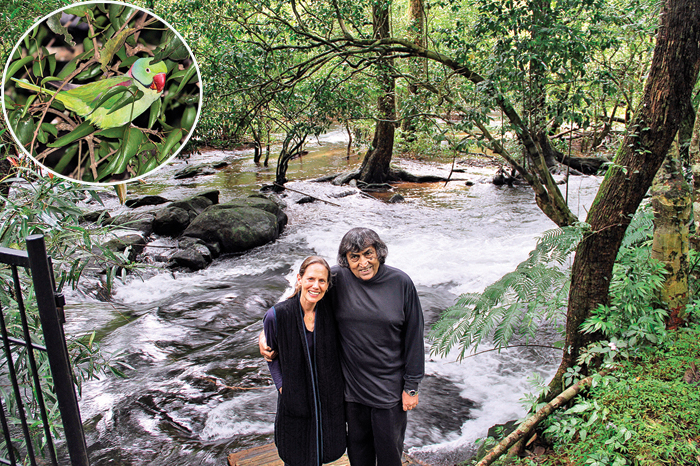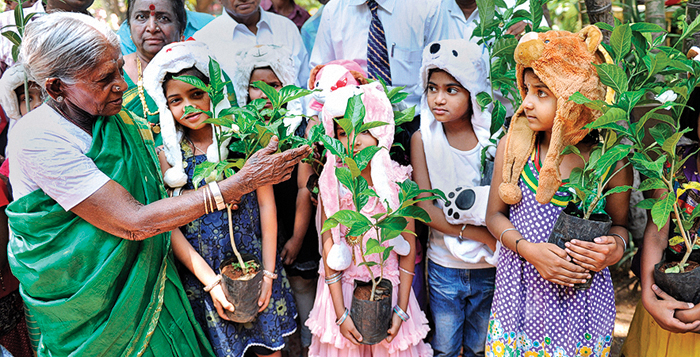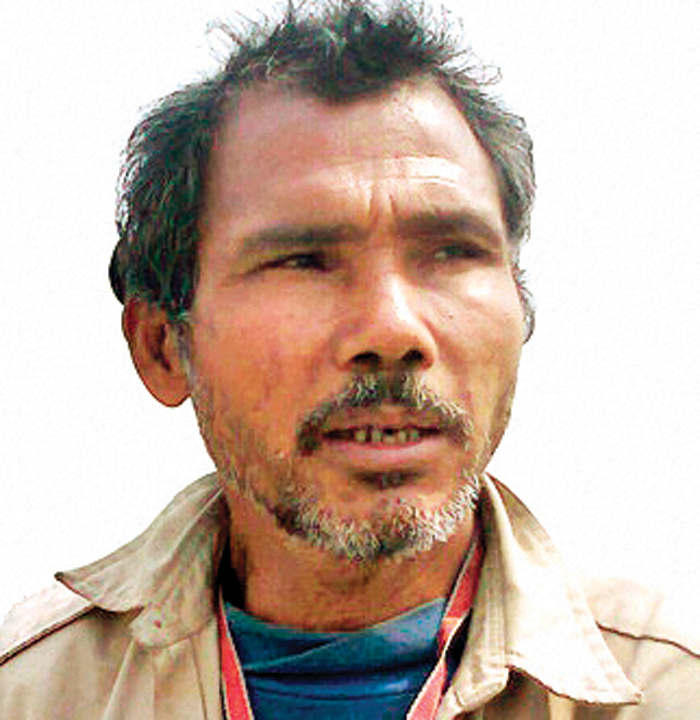
Dubbed Noah's Ark by a scientist from Oxford University, the SAI (Save Animals Initiative) Sanctuary in the heart of Kodagu (Coorg), Karnataka, was once a few acres of scraggly bushes and trees. Today, it is a verdant forest spanning over 300 acres of land, with a river rushing through and a diverse population of flora and fauna – all thanks to the efforts of one couple.
Anil K and Pamela Malhotra were always nature lovers – Anil having attended school in the Himalayan foothills of Dehradun, and Pamela climbing trees in her family estate in New Jersey as a child. When the two got married, it was a match made in naturalist heaven. They first bought some land in Colorado, USA, and then Hawaii, but eventually had to move due to logistical and monetary issues.

(Anil K Malhotra poses with wife Pamela Malhotra at the SAI Sanctuary; inset: Alexandrine parakeet)
They came to India at the start of the 1990s, with the aim to buy land to convert into forest cover in the Himalayas. However, with the Land Ceiling Act limiting them to just 12 acres of land in North India, the couple decided to look South. It was in the heart of coffee and cardamom land in Kodagu that they started to build their sanctuary, starting out with 55 acres of land in 1991. "Due to heavy rainfall in the area, conditions were not ideal for plantations. So the locals were happy to sell their land to us, and use the money to relocate to areas with better conditions," explains Pamela. "It was not completely barren land, but a mix of forested stretches near the cardamom plantations, and relatively deforested areas around the coffee estates."
The key to growing a forest, say the Malhotras, is to ensure that they are native to the environment. So when they began, the couple planted a variety of fruit trees including fig, guava, jamun, mango and jackfruit, among other native varieties, like garcinia and rudraksha trees, whose fruits are a favourite with the bats.
Today, SAI Sanctuary stands as India's only privately-owned wildlife sanctuary, though the duo work hand-in-glove with the Forest Department as well. "While most species that live in the jungle migrated here for the favourable habitat, The Forest Department also uses the Sanctuary for rehabilitation of animals," says Pamela. For instance, the Alexandrine parakeet, which has come close to extinction due to the illegal wild animal and bird trade, has found its home in the forest's environs.
Among other species, Bengal tiger, King Cobra, Asian elephant, and Nilgiri marten, are just some of the species have made the sanctuary their home.
With an Ecotourism section opened up and other simultaneous awareness programmes on their plate, the Malhotras have started to feel the pressure of handling their forest land on their own. In a bid to keep up with their own expansion, the couple have taken some time off from welcoming tourists to create quarters for the skilled staff members that they are looking to hire. "We'll be opening up the sanctuary for tourists in October, hopefully with a dedicated team of nature-lovers to help with the nitty-gritties of its functioning," she smiles.
Siddaramaiah shouldn’t come back to power. He has accumulated too much pride." One would think a 106-year-old would not be interested in politics, but that's not Saalumarada Thimmakka, the fiesty woman known the world over for the way she grew 385 banyan trees in the arid Ramanagara district of Karnataka, creating a green belt where none existed. The rows of trees (saalu mara in Kannada) earned her the sobriquet locally of Saalumarada, which has stuck.
The television set in the background is loud and clear as she speaks over the phone barely a day before the Karnataka assembly elections results were out. She still smarts as she recalls the time when the then CM invited her to his residence. "I was told that he wanted to meet and felicitate me for what I had done for the environment. I agreed to go along," she recalls. "There they gave me a `10 lakh cheque – not for what I had done but because I, as a Dalit, had done it."

(On the eve of her 102nd birthday, Saalumarada Thimmaka engages with young girls)
She claims to have never sought any privilege as a Dalit over the years and found the behaviour meted out to her in Bengaluru an insult. In fact, since the October incident she has refused to withdraw the `500 pension given to widows too. "My adopted son and well-wishers can take care of feeding me whatever little I need at my age."
Her self-respect stands tall like the 385 banyan trees that she and her husband planted along the 4km-stretch near Kudoor village leading to Hulikal in Karnataka. Born to a poor Dalit family in Gubbi village 142 km away, she had no formal education. "As soon as I was grown up enough to carry stones, I'd accompany my parents to the local quarry where they worked as casual labourers," she remembers. "In the afternoon when the sun beat down we would all gather under the only tree for lunch for the shade it provided. I must have picked up my love for trees from there."
Once she married Chikkaiah from Hulikal, the couple could not concieve. "We taunted for not having children, which made him angry but I would never retort – bearing it stoically," she says pausing, lost in those memories.
That is when she began planting trees with her husband and raising them 'like children.' Every year, the couple would plant 15-20 saplings and carry four large containers of water for watering them all the way, even covering them with thorny bushes to prevent them from being grazed on by cattle. Planted in the end of May, the arrival of monsoons in June would help the saplings become robust plants over three months and they would then survive without protection and water. Though her husband passed away in 1991, Saalumarada never gave up planting or "taking care of her children," who have all grown taller than her. "Some of the older ones are wider than my gnarled old hands can reach out to hug," she laughs.
In 1996, a local journalist's article on her caught the eye of then PM HD Deve Gowda and she was invited to Delhi, where she was conferred the National Citizen's Award. This opened the flood gates for recognition.
The Indira Priyadarshini Vrikshamitra Awards (1997), Veerachakra Prashasthi Award (1997), Karnataka Kalpavalli Award (2000), Godfrey Phillips Award (2006), Nadoja Award by Hampi University (2010), Vishwathma Award by Hoovinahole Foundation (2015), "She's Divine'' Award (2017) BBC recognised her as one among the 100 most influential and inspirational women of the world (2016), have all come her way. The awards continue to roll in as the Parisara Rathna award, the Green champion award and the Vrikshamatha award were conferred this year.
When we ask if she has any advice, all she says is "At least plant one tree a year and ensure it survives. Without trees we will all die."
One man army is perhaps the best way to describe 58-year-old Jadav Payeng, an Assamese man, who single-handedly grew a forest. It all started in 1979, when Assam's Social Forestry Division launched a scheme in 1979 to afforest a barren sandbar in the Aruna Chapori region along the Brahmaputra river. Each year as the areas around the river flood, it wipes off precious ecosystems. So as an experiment, the division decided to afforest this sandbar, to check if tree cover could protect the place from massive floods and erosion.
Unfortunately, the division soon ran out of funds to sustain the project and it was eventually abandoned, which led the unpaid labourers who were part of the project to leave as well. One 16-year-old labourer, however, continued the work, as he had seen the effect of the deluge up close – Payeng. The floods in his village in the late '70s had led to large scale devastation. "After the floodwaters receded, the temperatures soared. But there wasn't sufficient forest cover. I had seen scores of snakes, washed ashore by floodwaters, dying on the sandbar and the livestock plunging into waters to beat the heat. It was then I decided to grow trees all my life," Payeng had told DNA in an interview in 2013.

(Pic: Wikimedia Commons)
Today, this 550-hectare thriving forest called Mulai Kathoni, has a vibrant biodiversity housing a variety of species. Tigers, elephants and one-horned rhinoceroses being the iconic ones, but it also has deer, wild boars, vultures, pelicans, snakes, and wild buffaloes among many others. And over a 100 species of trees that includes varieties of custard apple, star fruit, jackfruit, banyan, bamboos, teak and several medicinal plants.
Payeng currently lives with his wife and three children in the Eklong Mishing Gaon, Kokilamukh, Jorhat. His efforts have helped several families living on the fringes of the forests, who depend on them for resources. One might think that he would now be content with the forest that he has managed to grow, but he has plans to grow another. In 2011, he started planting trees in another sandbar near the river, which is 2,000-hectares large. "I have already started the work with the help of students from various colleges and schools. It will take a long time to afforest this large area, but I will do it," he says with determination.
His work has won him recognition from across the country as well as internationally. He received the Sanctuary Asia's Wildlife Service Award (2012) and was also honoured at Jawaharlal Nehru University (2012) for his feat.
A few documentaries have been made around his work. In 2015, he received the Padma Shri, the fourth highest civilian award. Modest Payeng calls this forest the people's forest – not asking the state to demark it as 'protected forest area'. As long as India has people like him, maybe there's still hope for the environment.